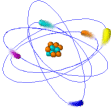An inkjet device that prints
tiny “bio-ink” patterns has been used to simultaneously
grow two different tissues from the stem cells of adult mice. Surgeons
could one day use the technology to repair various damaged tissues
at the same time, the researchers say.
Inkjet technology uses a fine stream of droplets to
build structures and is employed across many industries –
from computer chip design to large scale manufacturing.
It also has biomedical applications: researchers use
it to place very precise amounts of biological material, on the
microscale. For example, some groups have used the technology to
print cells, and “build” organs (see Print me a heart
and a set of arteries, and Replacement organs hot off the press).
Now, Julie Phillippi at Carnegie Mellon University
in Pennsylvania, US, and colleagues have demonstrated a novel bio-ink
printer that directs a population of muscle-derived stem cells from
adult mice to differentiate into both muscle and bone tissue. It
is the first such system to grow multiple tissues from a single
population of adult stem cells, the researchers say.
The technique works by firing various patterns of
different growth factor proteins onto the stem cells. By tweaking
the spatial patterning of the doses, using different print-heads
to deliver various concentrations of the protein “bio-ink”,
the cells can be directed to differentiate into different tissue
types, says Phillippi.
Muscle and bone
“Previously researchers have been limited to directing stem
cells to differentiate towards multiple lineages in separate culture
vessels,” says team member Phil Campbell. “The inkjet
printing technology allows us to precisely engineer multiple unique
microenvironments by patterning bio-inks that could promote differentiation
towards multiple lineages simultaneously.”
The team has already grown muscle and bone tissue
in the same dish. Their next step is to investigate “patterns”
for other tissue types that occur naturally in the body.
The researchers hope that the system will one day
help treat people with joint problems due to age or injury, and
those with conditions that cause tissue damage, such as muscular
dystrophy. And surgeons could one day use the technology in complex
operations.
For many injuries, diseases or genetic problems, often
cartilage, bone, muscle and fat are all damaged, says Phillippi.
“Why not repair it all at the same time?” she says.
The researchers presented their results at the annual
meeting of the American Society for Cell Biology on Sunday.
Related Articles
Print me a heart and a set of arteries
http://www.newscientist.com/article.ns?id=mg19025474.300
13 April 2006
Replacement organs, hot off the press
http://www.newscientist.com/article.ns?id=mg17723791.700
25 January 2003
Missing a few brain cells? Print new ones
http://www.newscientist.com/article.ns?id=mg18925366.500
30 January 2006
Weblinks
American Society for Cell Biology
http://www.ascb.org/
Carnegie Mellon Molecular Biosensor and Imaging Center
http://www.mbic.cmu.edu/home.html



